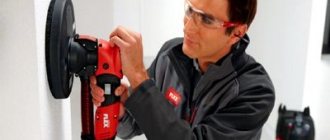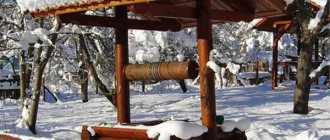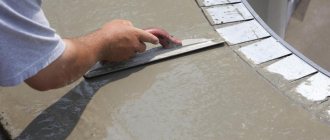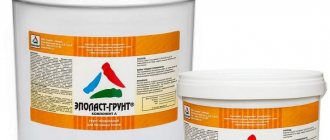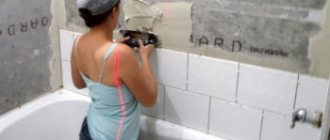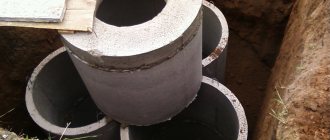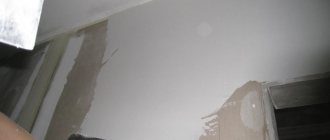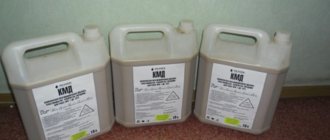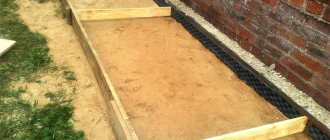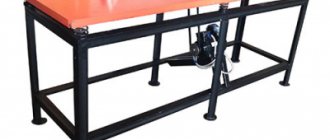There is nothing eternal in nature. This statement is especially true for concrete floors. The surface is subjected to intense mechanical action from shoe soles, feet, furniture legs and other objects. The floor is subject to constant load from placed interior items. Concrete is exposed to chemicals, humidity, and temperature changes.
Ironing of concrete surfaces makes it possible to obtain a durable concrete floor, due to which its service life is significantly increased.
Ironing of concrete
What is ironing
Ironing of concrete floors is a process after which the surface becomes more durable. Naturally, no metals are used in the process of floor processing. The surface of the screed is covered with liquid, colloidal or dry compounds, which, after drying or absorption, form a very strong layer.
During processing the following may be used:
- cement mixtures;
- special polymer compositions;
- colloids based on liquid glass.
Ironing of concrete surfaces must be carried out strictly following the technology. The answer to the question of how to make a floor strong and durable is simple: follow the recommendations of the manufacturer of a particular product and follow the general processing rules.
Mixtures for reinforced concrete
The final result largely depends on the technology chosen (dry or wet ironing) and the materials used. In the classic version, high-grade Portland cement is used in dry technology, while in wet technology, the same cement mixed with sand is used.
But today manufacturers offer a wide selection of ready-made mixtures in the form of fine powder, which, in addition to Portland cement, may include:
- ground marble, granite, quartz or corundum;
- modifiers that regulate the drying rate of wet-treated surfaces.
When choosing a ready-made mixture, it is important to consider that solid inclusions (stone flour) add strength to the concrete surface, but somewhat reduce the adhesive properties of the applied material.
For ironing using the dry method, a special polymer composition can be used - polyurethane powder. As a result of its rubbing into the wet surface of newly laid concrete, a durable, chemically resistant polymer coating is formed.
What are the different ironing methods?
Strengthened concrete floors, according to processing methods, are divided into the following types:
- wet;
- dry;
- treatment with a colloid with its penetration into the structure of the base.
The dry ironing method looks the simplest. It is made with cement, which is the main component of the dry mixture prepared independently. The situation is more complicated with the wet technique and the application of colloids. However, these methods are also available even when carrying out independent work and are not complicated.
Wet ironing
Let's look at how to reinforce a concrete floor using the wet method.
For this you will need:
- prepare a solution. Its composition is similar to that given for the dry processing method. The mixture of cement and sand is diluted with water and stirred to the consistency of thick sour cream;
- It is easy to obtain a solution with different qualities. For improved plasticity, lime milk can be added to it in a ratio of 1:10 in relation to the amount of cement. It is not difficult to obtain a surface with the desired shade of color by adding and stirring dyes. Adding liquid glass will increase water resistance and give the treated surface additional smoothness.
The application process is as follows:
- the liquid mixture is applied in a thin layer up to 5 mm;
- smoothing is done with a spatula or trowel;
- After setting and hardening, the surface is polished with grinding machines.
The wet method looks less attractive than the dry method in terms of labor costs and time consumption. However, it has an undeniable advantage: you can process not only horizontal, but also vertical surfaces.
Wet method
Types of ironing
Strengthening is carried out in two ways - wet and dry. The main feature of the wet method is its versatility, while dry processing is carried out only on horizontal planes.
READ Special dowel for foam block The dry method is easy to implement and inexpensive. Concrete is poured onto the surface to be treated and left for 5 hours to partially harden. After that, clean dry cement or a mixture based on it is applied to the wet surface. To prevent large particles from getting onto the coating, the procedure is carried out using a sieve with small holes. The layer thickness must be at least 3 mm.
After the cement absorbs the necessary part of the moisture, a dough-like mixture forms on the surface. It is rubbed into the concrete using a grater or trowel and gradually fills the pores of the concrete. Readiness for grouting is indicated by a change in the color of the powder to a darker one.
The final stage is treatment with impregnation to retain moisture. To properly reinforce concrete with cement, the material must be of a high grade with the addition of multicomponent mixtures that improve adhesion.
The advantage of the wet ironing method is its versatility - it can be used on any surface. A mixture of sand and cement is prepared in a 1:1 ratio, a lime additive is added to it - 10 percent of the total amount of solution. Lime makes the mixture plastic and protects against cracks.
When strengthening vertical bases, the solution should have a thicker consistency. It is applied with a spatula or pneumatic sprayer. Ironing of the concrete surface using the wet method is carried out 14-28 days after the concrete has been poured. Thus, wet strengthening can be used for the restoration of old structures.
Polymer impregnations allow you to reinforce concrete yourself and get excellent results. Colloidal mixtures are based on liquid glass and polyurethane.
Strengthening with liquid glass has several advantages, the main ones being quick drying and smoothness of the coating. The disadvantage is that when the floor is wet, the glue is gradually washed away and the strength decreases.
READ Concrete dyes: types of pigment and DIY production
Polyurethane mixtures have proven themselves to be the most effective method of strengthening. Polymers have the ability to penetrate pores to a depth of 5 mm, strengthening the surface. The unique properties of polyurethane allow it to be used even at low air temperatures. To obtain a protective layer, the impregnation is applied with a special sprayer, and after an hour the concrete is wiped with a special brush.
Polyurethane can be used to strengthen old structures to prevent further destruction. Before ironing begins, the concrete is cleaned of dust and contaminants, after which it is thoroughly impregnated with a primer in several layers. The primer must have good penetrating properties. Strengthening is performed using the wet method.
Strengthening the blind area
The blind area is a multi-layer waterproofing protection for the house. However, it needs additional strengthening and durability. First of all, because it is this part of the building that is exposed to the elements.
Pouring concrete is the final stage of building a blind area. Its ironing is carried out 2 weeks after the main work. Any method is suitable for strengthening the structure. With the dry method, plasticizers are added to the cement, which makes it possible to strengthen the top layer.
Wet strengthening of the blind area is done after the concrete has not completely dried. If necessary, the quality of the solution is enhanced with liquid glass. To retain moisture, the surface is covered with a piece of polyethylene. In hot weather, it is necessary to periodically moisten the blind area using a spray bottle. Wet strengthening is carried out two weeks after concreting. This is necessary to stabilize the structure of the structure.
Topping processing
The development of special finely dispersed compositions makes it possible to achieve maximum adhesion to the concrete coating and improve its technical characteristics. In addition, waterproofing properties, resistance to vibration and mechanical loads, aggressive environmental influences, and dust formation are significantly increased.
READ Geotextiles for paving slabs: technology review
Topping mixtures are divided into three groups according to the degree of strength - quartz (medium), corundum (strong), metallized (extra strong).
The most popular quartz filler is used in rooms with high humidity and load - in bathhouses, swimming pools, and warehouses. The concrete base, reinforced with quartz topping, is intended for long-term use. The addition of dyes is suitable for decorative processing.
Corundum fillers not only significantly strengthen concrete, but also reduce its ability to abrasion several times. Mixtures of corundum chips are used at gas stations and parking lots, in industrial premises with a large amount of equipment, and in underground parking lots.
Topping containing metal shavings is used for reinforced surfaces with high strength in factories or other enterprises. Due to its tendency to corrosion, it is not used in social or residential buildings.
Topping technology is complex and requires experience and special equipment. At the initial stage, the mixture is applied 6-7 hours after pouring. Most of the mixture crumbles and is distributed over the concrete plane. After the hardener absorbs moisture, the base is smoothed using trowels. The remaining topping is applied immediately and rubbed over again. After 2-3 hours, the plane is sanded, impregnated with curing and covered with a polyethylene film until it hardens completely.
After two days, shrinkage or expansion joints measuring 6 x 6 meters are cut out on the finished surface using a grinder, going approximately one-third deep into the slab. After 2-4 weeks they are filled with polyurethane filler to seal.
Treatment with colloidal compounds
Today on the market there is a whole range of ironing agents used in the form of colloids. These are mixtures of different compositions based on liquid glass, as well as polymer ones, the basis of which is polyurethane.
Before processing, concrete must be cleaned and (if possible) primed. After this, the colloid, previously diluted to the consistency of liquid sour cream, is poured onto the screed and stretched with a trowel or spatula. Unlike the wet processing method, the colloids are mostly absorbed into the concrete base.
Application of dry polymer compositions
An expensive, but very convenient option for builders, ironing involves the use of powdered polymer mixtures. The processing technology is similar to the dry method: using a sieve, the composition is distributed over the surface, absorbs moisture, rubbed and polished.
Unlike the use of cement and sand mixture, the polymer composition allows you to work at any air temperature, up to -25 below zero Celsius. However, there are also disadvantages of such processing: the moisture content of the concrete screed should not be excessive, otherwise an uneven layer may form, which will complicate final grinding and emphasize defects in the base.
Purpose of ironing
Traditionally, concrete and iron are considered the most durable structural materials. The technology for surface compaction of iron is called cementation, concrete - ironing, although the materials indicated in the names are not used in either of them.
The main requirement of joint venture standards in the manufacture of multi-layer floor and ceiling pies is to increase strength from top to bottom. In other words, under the floor covering there must be a base with higher strength and wear resistance.
Destruction of concrete screed due to violations of manufacturing technology.
When concreting screeds independently, the developer often makes mistakes and violates technologies:
- W/C – the water-cement ratio is not maintained, excess moisture accumulates on top, reducing the strength of the screed;
- lack of vibration compaction - unlike walls, foundations and stairs, screeds are of insignificant thickness, the tips of deep-seated vibrators are useless here, and vibrating screeds are used by about 15% of individual developers; air bubbles remaining in the concrete reduce the characteristics of the structural material.
When the W/C ratio is maintained, all concrete components are in a bound state, moisture cannot leave the mixture, and large and small fractions of the filler cannot settle down, depleting the top layer of the structure.
After covering the screeds with linoleum, laminate, and other coatings, operational loads are transferred to the defective concrete. The base begins to paint and dust. Ironing is designed specifically to solve these problems.
When the pores in the surface layer are clogged with special compounds, in addition to increasing strength, the vapor permeability of concrete increases and its hydrophobicity decreases.
In some cases, this is harmful to the structure, for example, moisture can accumulate between the iron and the laminate laid on top of it, and fungus and bacteria can develop (at high humidity).
How ironing improves the efficiency of construction work
Floors on iron beams are very often found in the practice of builders. This can be a specially created structure, when a building is erected from scratch. Or, processing of such an overlap has to be done during work in existing buildings.
Steel beam floors have many advantages. It is easy to make a floor over a long span of up to 6 meters, calculating the required parameters of a shaped profile is not difficult (there are a lot of standardized methods), floors can be insulated without problems, and high noise protection is provided.
The ceiling on a steel shaped profile has one main drawback: the screed on the surface is quite small (reinforced, up to 50 mm is recommended), so the wear of concrete very quickly can make it necessary to lay the base again. In addition, floors on a metal profile have a relatively low load capacity and are prone to some deformation. Therefore, the screed experiences additional loads, which contribute to the destruction of concrete over time.
Ironing sounds like the answer to the question of how to make the surface of a concrete floor on iron beams strong and durable. When carrying out treatment, it is recommended to use colloidal solutions that penetrate directly into the surface of the concrete.
Ironing tools
When leveling the surface and performing troweling when ironing with your own hands, it is recommended to use a trowel. This tool will take more time, but the achieved result will be better, and the surface will be more stable and durable.
To achieve high speed of work with wet technology for ironing large areas of the floor, you can use mechanical trowels. Their use is especially attractive when using polymer liquid mixtures and colloids. Using a mechanical method, you can efficiently rub the ironing composition into the top layer of the screed.
It is recommended to use grinding machines to treat the concrete surface with a polymer dry mixture. Using a power tool with a reciprocating pad motion, you can quickly and evenly rub the reinforcing compound into the screed. This guarantees the formation of a surface with stable strength over the entire area.
Circular sanders are ideal for sanding iron-treated floors. They show optimal performance in terms of time spent and obtaining an even, smooth surface. It is not recommended to use sanders with sandpaper looped into a tape. This class of tool will not allow precise control of the processing quality.
After the ironing procedure, the floor surface acquires very high strength. Therefore, the use of a hammer drill for gating when laying wiring becomes ineffective. To work with iron-treated concrete, it is recommended to use diamond drills, and to form grooves, wall chasers or grinders.
Application specifics
Iron plating of concrete surfaces is in demand in industrial, public and private construction.
Ironing the cement screed makes it stronger, removes dust, and waterproofs it. Any floor covering can be laid on such a screed.
Ironing a concrete floor allows you to create a coating that is resistant to abrasion, moisture and aggressive substances. Such floors are used in industrial workshops and utility rooms.
Ironing of blind areas, monolithic concrete paths and platforms, and freshly made paving slabs makes hard surfaces resistant to atmospheric influences. The compacted top layer acquires water-repellent properties and better withstands mechanical loads.
Iron reinforced concrete walls are usually used in the construction of artificial reservoirs, swimming pools, and tanks. The technology helps waterproof monolithic structures.
Ironing the surface of the plaster prevents it from cracking and gives the surface water-repellent properties. This technique is used for waterproofing walls in wet rooms and basements.
